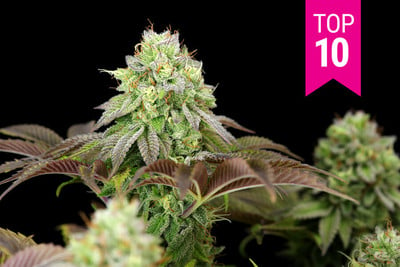The Complete Guide To Cannabis Concentrates
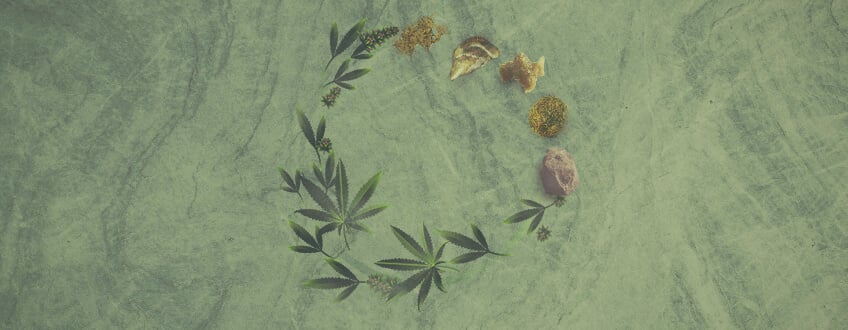
Contents:
- 1. History of cannabis concentrates
- 2. Types of concentrates
- 3. Potency of concentrates
- 4. Shop-bought vs. Homemade
- 5. Which strains to use to make concentrates?
- 6. Terpenes and concentrates
- 7. How to consume concentrates
- 8. Benefits of concentrates
- 9. Disadvantages of concentrates
- 10. The wonderful world of concentrates
Concentrates are one of the fastest-growing sectors of the cannabis industry. While cannabis flower is still the leading way to consume the plant, use of concentrates is growing at a faster rate. Sales of concentrates are expected to overcome flower sales by 2022.
Concentrates are forms of cannabis where the active elements are packaged in a form more concentrated than they’d be in the cannabis flower. Kief is the simplest form of cannabis concentrate. Other examples of concentrates include hash, BHO, and CO₂-extracted concentrates. Technically, tinctures and edibles are concentrates, but in this article we’re going to focus on concentrates that can be smoked or vaped.
At this point, you may have more questions than answers. What are the different kinds of concentrates? Can you make them at home? How are they consumed? We’ll address all these questions, but first, let’s take a look at the history of cannabis concentrates.
HISTORY OF CANNABIS CONCENTRATES
Despite their high-tech reputation, concentrates are far from the new kid on the block. They originated in the ancient world in the form of hashish, or hash. Hash originally came from China, but became famous through its use in India and the Middle East. It even appeared in <i>One Thousand And One Arabian Nights</i>.
Hash came to Europe in the 18th century, with writers like Gmelin detailing its medicinal properties. The popularity of hash grew after the Napoleonic Wars when French troops were introduced to hash in Egypt. The intelligentsia of Paris soon founded the “Club des Hashischins”, a community built around its use. Its members included Victor Hugo, Charles Baudelaire, and Alexandre Dumas.
Meanwhile, hash made quite the splash in the medical community. Samuel Hahnemann, founder of homeopathy, argued for its efficacy in 1811, and by the late 1800s, hash was being used as a treatment for a variety of conditions including insomnia, pain, migraine, and menstrual issues.
However, a storm was brewing on the horizon. With the rise of drug prohibition in the 20th century, hash soon found itself on the run, a fugitive substance with a target on its back. With the 1961 UN Single Convention on Narcotic Drugs, hash was criminalised globally, and the golden age of legal hashish came to a close.
Hash was forced underground, but it was not defeated. Morocco became the world’s leading exporter of hash, supplying the world with high-quantity, low-quality “soap bar” hash. Since the 1990s, Afghanistan has regained its foothold as leading hash exporter, and has reintroduced quality hash to the global market.
As hash made its way through the underground, a new kind of concentrate was born. In the 1970s, weed technologists used alcohol, activated charcoal, and honey to produce “hash oil”, a concentrate with higher THC levels than traditional hash. Hash oil rapidly gained in popularity, and even featured in the CIA’s MK Ultra experiments as a possible candidate for mind control.
Much of the history of concentrates is “concentrated” within the last 20 years. In 1999, instructions for butane extraction began to circulate on the internet. In 2005, Canadian Budderking popularised both the technique for producing budder, and the dabbing rig, a way to consume concentrates rapidly and efficiently. Since then, hash oils have grown in sophistication and prestige, and are poised to become the face of the global cannabis industry.
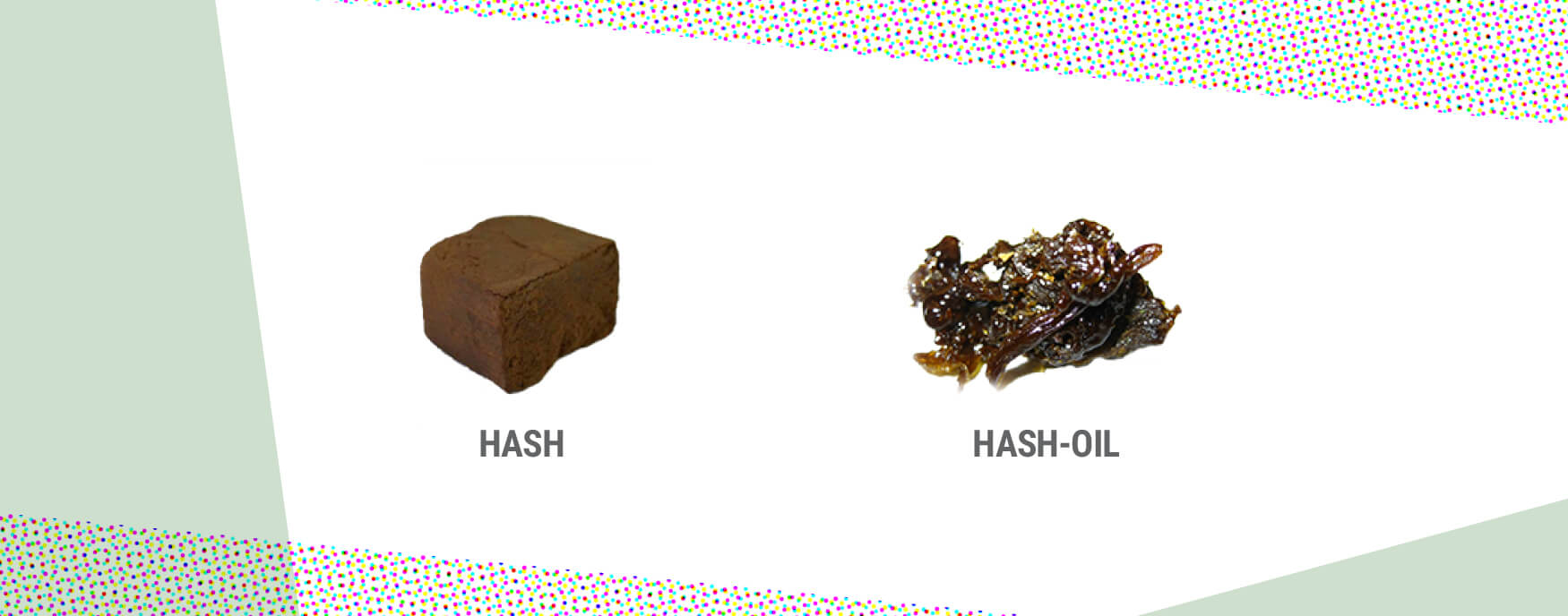
TYPES OF CONCENTRATES
Concentrates are divided into two main categories: those that are extracts, and those that aren’t. Extracts are made with the use of a solvent, and are often referred to as hash oil. Non-extract concentrates include hash, rosin hash, and kief. Bubble hash is not considered to be an extract, even though it uses water as a solvent—in the world of cannabis, water is not considered a solvent.
There are two ways to categorise extracts: according to solvent, and according to consistency. Some solvent-based categories include BHO, which uses butane as solvent, PHO, which uses propane as solvent, CO₂-based extractions, which use supercritical CO₂ as solvent, and alcohol-based extracts, which use alcohol.
Extracts can also be categorised according to consistency. Wax refers to waxy, opaque extracts; sap refers to gooey, transparent extracts; shatter refers to extracts that are hard and transparent like glass; pull 'n' snap refers to extracts with a consistency like toffee; budder refers to extracts with an opaque, fluffy texture.
Different consistencies can be achieved by varying the speed and conditions under which the extract cools during production. Budder, for example, can be made by “whipping” the extract on its cooling plate. Contrary to popular belief, consistency has little effect on an extract’s psychotropic or medicinal properties.
Click here for more info on how to make extracts and other concentrates.
POTENCY OF CONCENTRATES
Concentrates work by breaking open the delicate trichomes of the cannabis flower and compressing their contents together. As such, they’re rich in cannabinoids and terpenes, which provide the effects of cannabis.
Concentrates are popular for two reasons: one, they tend to be far higher in THC than leading cannabis strains, providing far more of an intoxicating punch. Two, they tend to be richer in medicinal cannabinoids and terpenes, thereby enhancing the medicinal effects of cannabis.
Potency is a concentrate’s greatest strength, but also its greatest danger. Inexperienced users may find themselves overwhelmed by their first dab, perhaps knocked into the throes of paranoia or unpleasant feeling. As such, those new to concentrates should begin with small doses and proceed with caution.
SHOP-BOUGHT VS. HOMEMADE
As with cookies, the most important question a concentrate user has to ask themselves is whether to buy shop-bought or homemade. A typical user has three options: to buy commercial concentrates, to buy concentrates from home operations, or make them themselves. To address this dilemma, we need to delve a little more deeply into the different kinds of concentrates and how they’re made.
When it comes to non-solvent based concentrates, many users will choose to make concentrates at home. After all, anyone using a kief catcher is technically a home-concentrate-maker. Stockpiled kief can be added to joints, sprinkled in coffee, or used to make moon rocks.
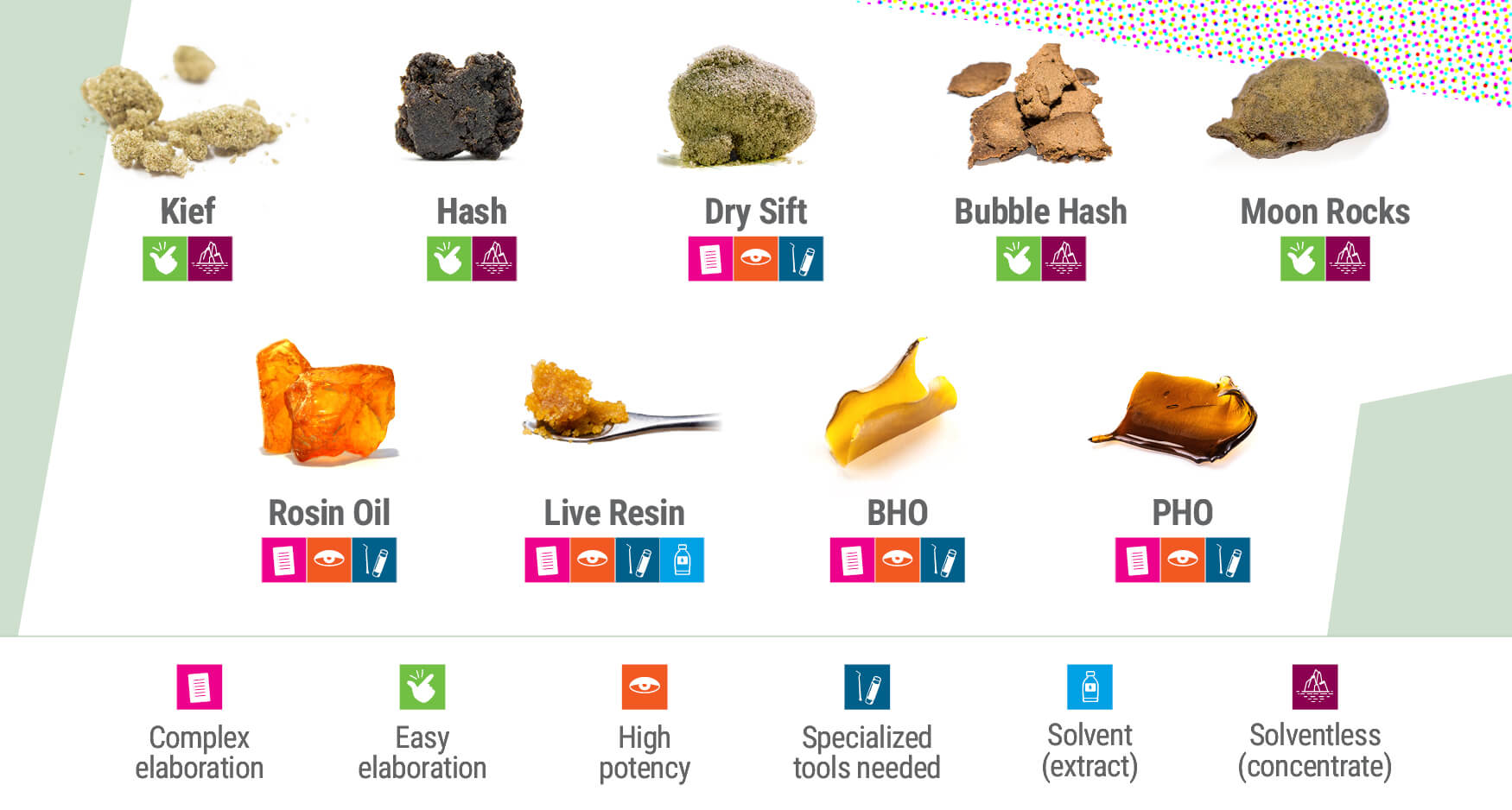
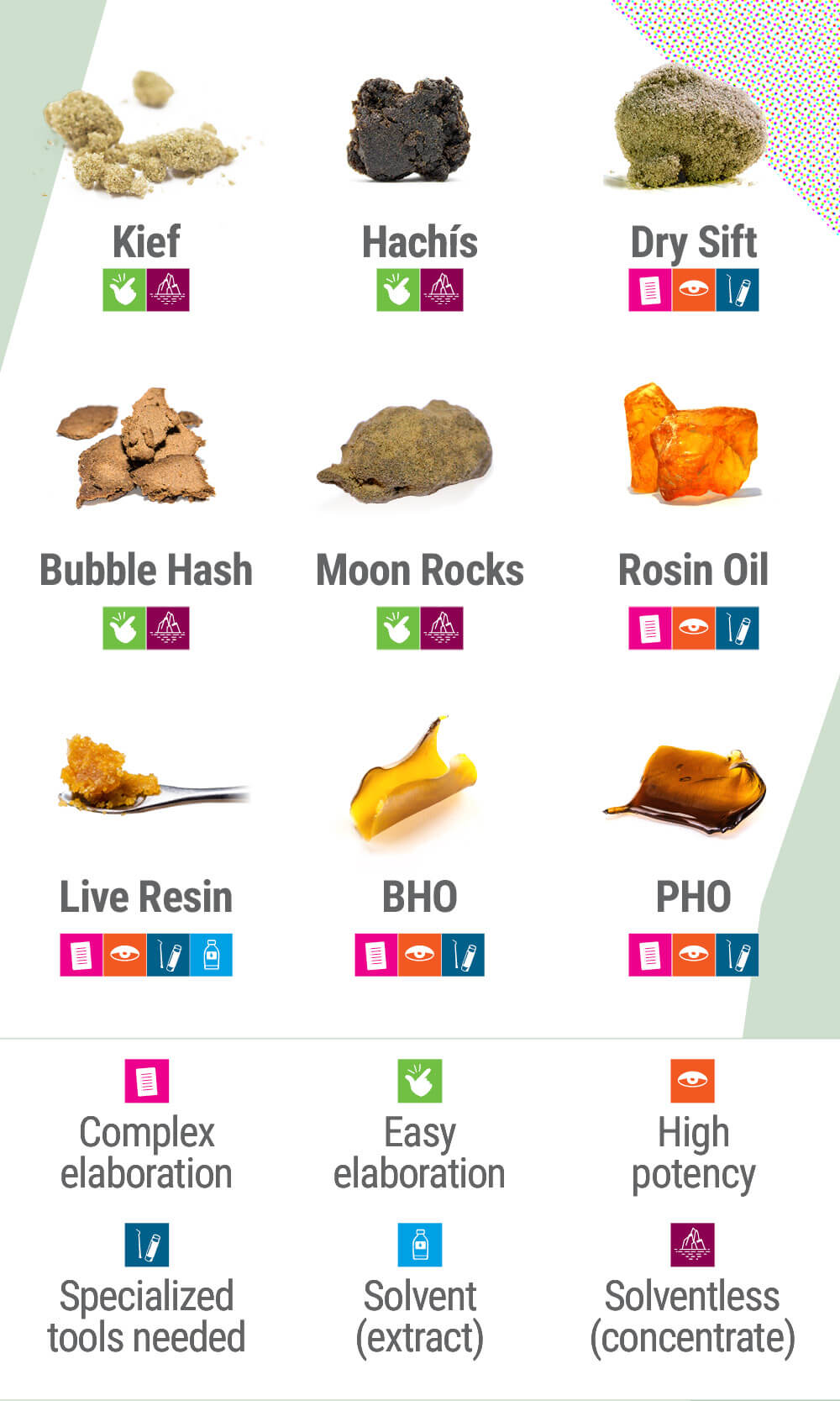
There are also several ways to make hash at home. Some users opt for the simplicity of shoe hash, where kief is packed into an airtight bag and placed in the heel of one’s shoe. Throughout the day it gets walked on, and in the process becomes heated and compressed into hash. Another option is rosin hash—this is where cannabis flowers are folded into wax paper and then compressed with a hair straightener, releasing a resin with similar properties to BHO. There are several other methods for making hash, using blenders, compressors, and agitation with ice. Different methods of producing hash have different properties, but what they all have in common is that due to the lack of solvents, all methods are equally safe.
Extracts are a little more complicated. Two of the most popular—BHO and PHO—carry some risk. Butane extraction involves explosive materials, and some home-extractors have blown up their kitchens in the process of making it. Another danger with BHO or PHO is the possible presence of contaminants in the final product.
If new to home-based extraction, don’t start with BHO or PHO. Instead, try an alcohol-based extraction, which carries little risk and is a great way to get the hang of the process.
Shop-bought extracts tend to be produced using supercritical CO₂ extraction. This method allows producers to extract a wide range of cannabinoids and terpenes intact, without the risk of contaminants. Supercritical CO₂ is the leading method of commercial extraction at the moment. However, the equipment required to carry it out is extremely expensive, so you’re unlikely to see it in any home labs.
WHICH STRAINS TO USE TO MAKE CONCENTRATES?
One of the most important choices in the process of making concentrates is which strain to start with. Just as you can’t pull blood from a stone, you can’t pull THC from a zero-THC strain, for example.
There are a few basic dimensions to consider when picking a strain. The first is where the strain autumns along the indica-sativa spectrum—indicas tend to be more relaxing, with powerful body effects that can spark both hunger and sleepiness. Sativas tend to be more energising, producing a “head high” that can be uplifting, creativity-inducing, and at times anxiogenic. It’s also important to pay attention to a strain’s THC levels—which determine the strength of its psychotropic effects—and CBD levels, as CBD is tied up with many of the medicinal effects of cannabis.
If you’re looking for a high-THC strain, you can’t go wrong with Royal Gorilla. This balanced indica/sativa hybrid clocks in at a staggering 30% THC—truly off the charts. If you’re looking to use your concentrate to treat a medicinal issue like chronic pain, anxiety, or epilepsy, you’d likely want to start with a strain that’s high in CBD. Euphoria is a great choice, being an indica-dominant strain with 7% CBD. A very different but also strong choice is Painkiller XL, a sativa-dominant strain with carefully balanced levels of THC and CBD.
TERPENES AND CONCENTRATES
Another factor in strain selection is picking one with the terpene profile you’re looking for. Terpenes are responsible for the flavour of cannabis strains. They also modify the psychoactive effects of cannabis, and are responsible for many of cannabis’ medicinal effects.
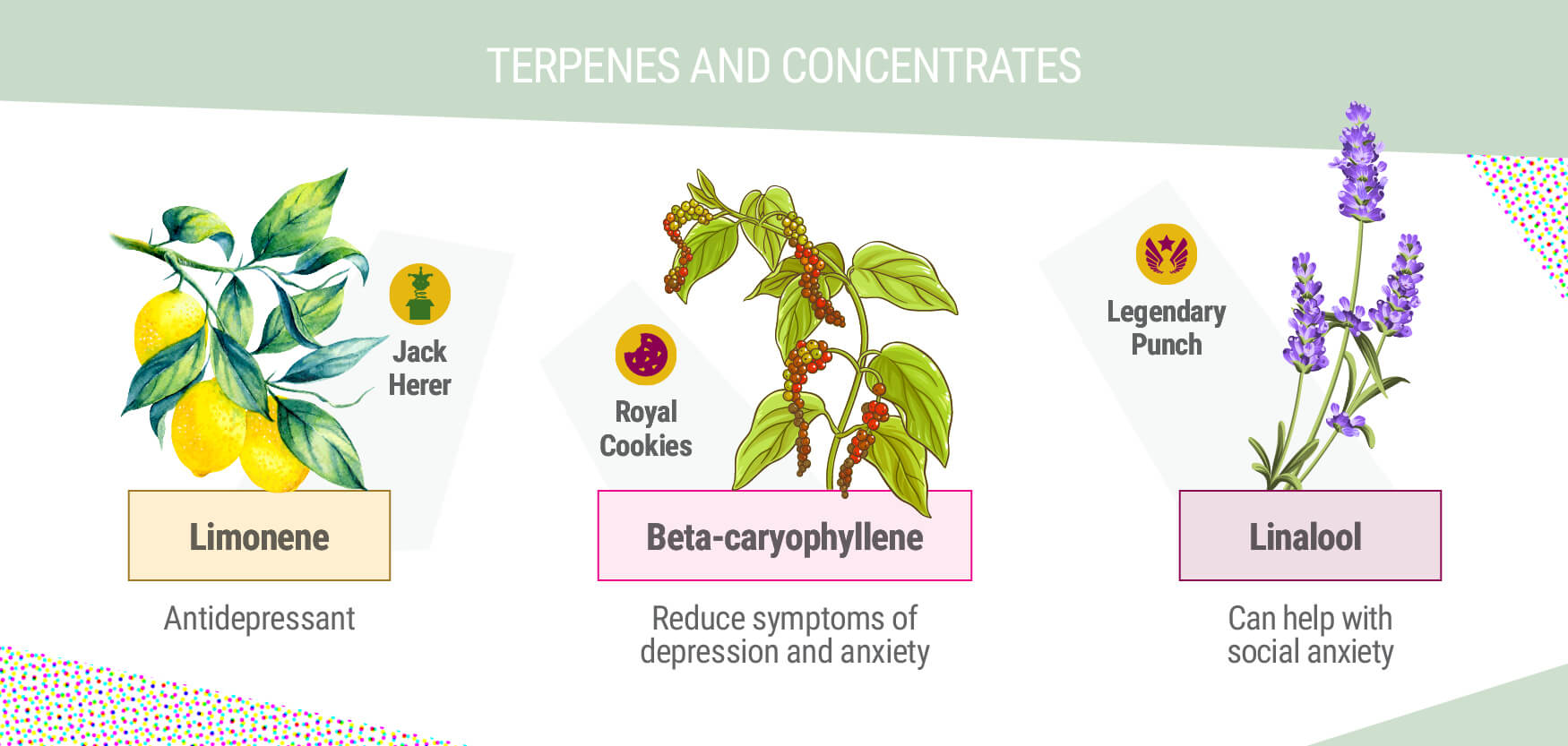
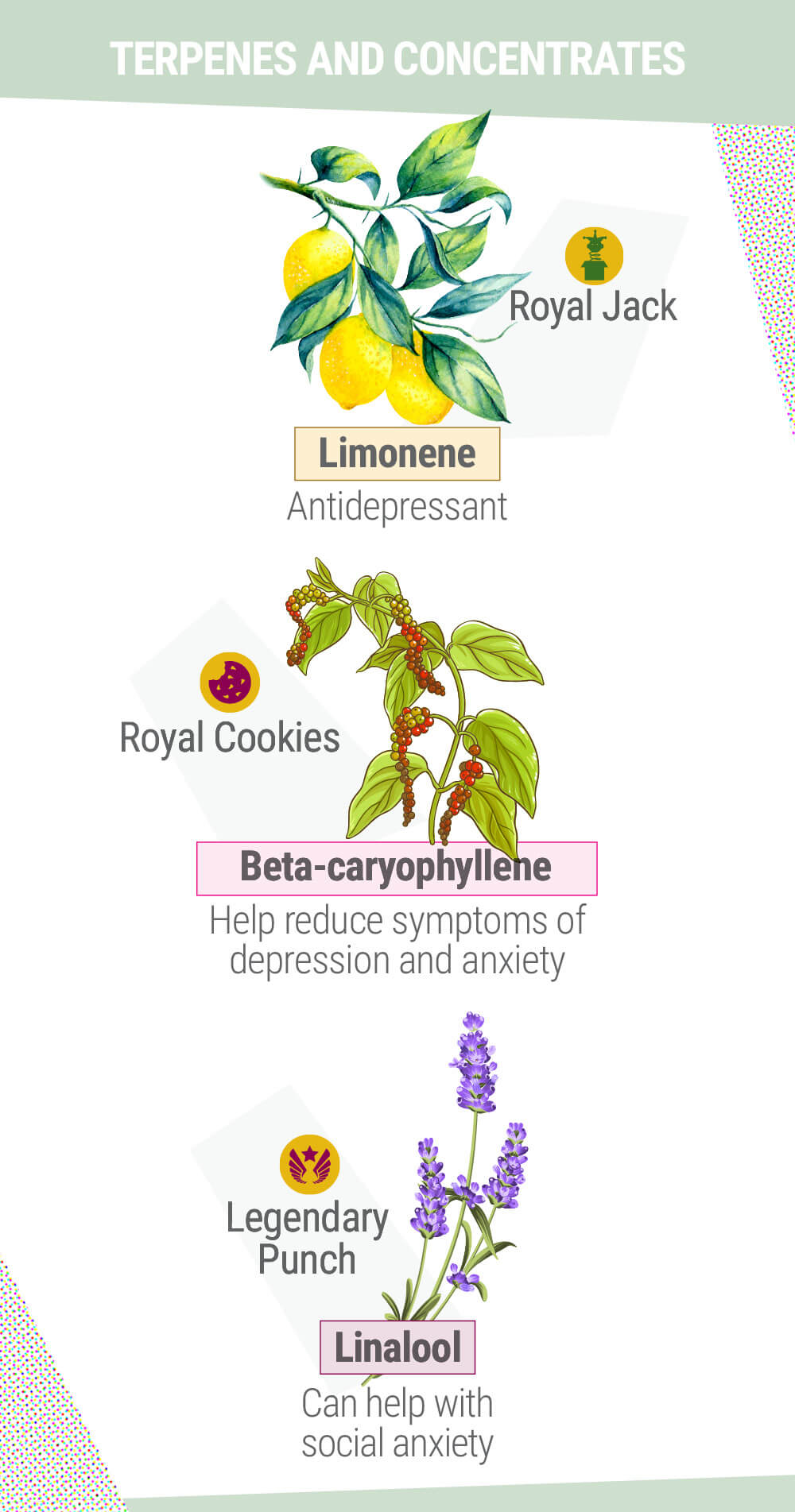
One notable terpene is limonene. It has antidepressant properties, so when choosing a strain to fight that malady, it’s a good idea to look for this terpene. Jack Herer is rich in limonene and packed with THC. Another notable terpene is beta-caryophyllene, which has been found[1] to reduce symptoms of both depression and anxiety when given to rats. Celebrated and uplifting strain Royal Cookies contains beta-caryophyllene. If you have social anxiety or aggression issues, consider finding a strain that contains linalool, which may help with[2] these conditions. Strains descended from Grand Daddy Purple, like Legendary OG Punch, are usually high in linalool.
When consuming terpenes in concentrates, it’s important to be mindful of temperature. Terpenes tend to be more sensitive to heat than THC and CBD, and can easily be blasted away with high dabbing temperatures. If you’re a dabber looking to preserve your terpene profile, stick to low-temperature dabbing.
HOW TO CONSUME CONCENTRATES
Concentrates can be consumed in several ways. They can be baked into edibles using similar methods to those you’d use for the cannabis flower. They can also be added to cannabis flower joints or bowls. But the most common way to consume concentrates is by vaping or dabbing.
Vapes pens are an especially popular way of consuming concentrates. They’re the leading method for consuming shop-bought CO₂ concentrates, though they can be used for any kind of hash oil, or for hash itself. Vape pens are discreet, simple to use, and tend to provide a milder, more manageable high.
At the other end of the spectrum, dabbing is a method for consuming concentrates that involves vaporising the substance using a hot nail, and then inhaling its vapor through a kind of repurposed bong called a “dab rig”. More detailed instructions can be found here. As mentioned above, this method is considered to be quite potent, and takes some time to get used to.
BENEFITS OF CONCENTRATES
Concentrates have several benefits. For one, they’re much stronger than cannabis flower, allowing for stronger highs, more powerful medicinal effects, or, if you prefer, equal effects for less product. Since the active ingredients aren’t bundled up with so much plant material, concentrates tend to be easier on the lungs. Moreover, concentrates tend to last longer than regular bud, although proper storage is still vital.
DISADVANTAGES OF CONCENTRATES
The disadvantage of concentrates is identical to their advantage: potency. Concentrates are powerful medicine, and as such, can be overwhelming for the unprepared. If you’re new to concentrates, and especially if you’re new to dabbing, be sure to err on the side of low doses.
THE WONDERFUL WORLD OF CONCENTRATES
This may seem like a lot of information, but as with anything, the best way to learn is by doing. Pick whichever kind of concentrate seems most interesting to you, and jump right in. Who knows? You may discover your new favourite way to consume weed.
- β-Caryophyllene, a CB2 receptor agonist produces multiple behavioral changes relevant to anxiety and depression in mice. - PubMed - NCBI https://www.ncbi.nlm.nih.gov
- Effects of inhaled Linalool in anxiety, social interaction and aggressive behavior in mice. - PubMed - NCBI https://www.ncbi.nlm.nih.gov


























